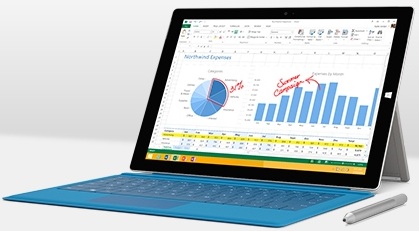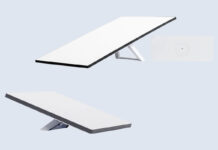
Technology is a big part of student life and a computer has become integral to the educational experience. Microsoft’s Surface Pro 3 is a powerful device that can physically transform into a laptop form factor, becoming a true ultra-mobile alternative to a laptop or desktop PC —while offering all the advantages of a tablet.
Microsoft says this is the tablet that can replace your laptop, and that claim isn’t just marketing. Thanks to the Surface Pro 3’s combination of power, portability and flexibility, this is a device that truly can replace the traditional laptop/tablet combo we’ve become accustomed to. For a student, this is a very attractive option, with the potential to save money over buying multiple devices while cutting down on the amount of gear to be lugged around.
PC Power in a Tablet Form Factor
Tablets offer a huge advantage over laptop PCs in terms of portability, but the tradeoff is that these devices use mobile processors, a mobile operating system and run apps instead of the desktop software you might be accustomed to.
 The Surface Pro 3 is very different from traditional tablets. It’s bigger than most, with a 12-inch Full HD display. That makes the Surface suitable for working with detailed files like spreadsheets.
The Surface Pro 3 is very different from traditional tablets. It’s bigger than most, with a 12-inch Full HD display. That makes the Surface suitable for working with detailed files like spreadsheets.
And unlike Android tablets or iPads, the Surface Pro 3 runs Microsoft Windows Pro 8.1, meaning this tablet is capable of running the same Windows software applications you buy for a desktop PC.
It will run apps downloaded from the WIndows Store too. And yes, you can play games on it! I’m rather fond of “Halo: Spartan Assault.”
To provide the power to drive Windows, the Surface Pro 3 uses a PC processor, the same 4th generation Intel Core CPUs you’ll find in laptop and desktop computers (Core i3, i5 and i7 options are offered). It also offers the range of ports you’d expect from a PC, including USB 3.0, Mini DisplayPort and a microSD Card slot.
The Tablet Advantage
Despite packing the power of a traditional computer, the Surface Pro 3 retains the advantages of a tablet. It’s much thinner and lighter than convertible laptops and ultrabooks, and comes with an aluminum Surface Pen for handwriting or drawing —perfect for taking notes during lectures.
Of particular interest for the student crowd, clicking that Surface Pen will automatically wake the Surface Pro 3 and launch Microsof OneNote, a pretty handy trick.
Smart Keyboard Cover
One of the Surface Pro 3’s best tricks is achieved when you pair it with an optional Surface Pro Type Cover.
Thanks to the sturdy and incredible adjustable kickstand, along with carefully placed magnets, the Surface Pro 3 combined with this smart cover transforms the device into a laptop.

The cover not only provides the expected protection for the display during carrying, it morphs into an adjustable keyboard and trackpad that makes typing a breeze.
I’ve used it and the keyboard provides a vastly superior experience to the virtual keyboards used with most tablets, while the entire device is remarkably solid.
Accessories
Besides the colourful and versatile keyboard covers, the Surface Pro 3 can be used with a wide range of PC peripherals to expand its capabilities. Bluetooth keyboards and mice and external monitors can transform this tablet into a full-fledged desktop PC if you want while microSD cards offer inexpensive storage expansion.
Microsoft also offers accessories designed specifically for the Surface Pro 3 such as docking stations.
Looking for more information on the Surface Pro 3? Read about my experience using one at Microsoft’s Surface Cafe event in Toronto.



